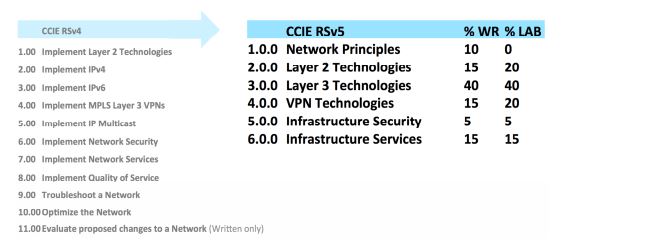
Cisco announced the much awaited update for CCIE Routing and Switching from version 4 to version 5. It’s a good move as CCIE R & S version 5 is there since pretty long time. The official launch for the version 5 happens to be on June 4th 2014. This brings a great relief for those who are preparing hard and almost very close to appear for the lab exam. Coolly there is a window of months for people like me to prepare and appear for the version 4 of the Routing and Switching lab exam.
The announced changes are targeted for both written and lab exams with few exception like a domain of Network Principle which is purely targeted to written exam, below are the comparison between version 4 and version 5.
Technical Topic Changes
New Lab Topics:
- Interpreting Packet Captures
- Bidirectional Forwarding Detection (BFD)
- Multi Address Family (AF) EIGRP
- Dynamic Multipoint VPN (DMVPN)
- IPsec
- IPv6 First Hop Security
Of the new topics announced, the big ones are DMVPN and IPsec. These are specifically listed as DMVPN Single Hub and IPsec with Pre-Shared Keys, so the scope is not nearly as large as the CCIE Security.
Topics moved from the Lab to the Written:
- IPv6 Multicast
- RIPng
- IPv6 Tunneling
- IOS AAA with TACACS+ and RADIUS
- 802.1x
- Layer 2 QoS
- Performance Routing (PfR)
Topics will be no longer seen in the version 5:
- Flexlinks
- ISL
- Layer 2 Protocol Tunneling
- Frame-Relay
- WCCP
- IOS Firewall
- IOS IPS
- RITE
- RMON
- RGMP
- RSVP QoS
- WRR/SRR
For topics removed, there are three killer areas here: Frame Relay, PfR, and Layer 2 QoS. Frame Relay’s removal is no surprise, as Ethernet based last mile access solutions such as Metro Ethernet and Virtual Private LAN Services (VPLS) have exploded in the past few years and have eclipsed legacy methods such as DS3 Frame Relay. From a technology design point of view though, a lot of the Frame Relay theory transfers directly over to DMVPN, as DMVPN could be thought of as a way to emulate legacy hub-and-spoke network designs over a public transport.
While the general idea of PfR is great, I’ve never seen it implemented other than in very small scale environments due to the management complexity. You have to give Cisco credit though, as PfR is essentially SDN version 1.0, and now a very large portion of the industry is focused on this type of application.
The other large change here is the removal of Layer 2 QoS. While this is still a very important topic, the problem with L2 QoS is that it is highly platform dependent, and the way that Catalyst 2960/3560/4500/6500 implement L2 QoS is generally unique to each. Therefore in the interest of platform independence and virtualization, L2 QoS gets the axe.
Equipment Changes
As previously rumored, the new CCIE R&S v5 equipment is going all virtual. As CCIE R&S v4 had already been using virtual IOS for the troubleshooting section of the exam, this should come as no surprise. The biggest implication of this change is that the size of the topology is now arbitrary. I wouldn’t be surprised going into the exam and seeing a configuration section with 20+ routers in the topology.
The other implication of this change is that certain features can no longer be tested on, as they’re not supported in the virtual IOS. Those topics that can’t be tested, such as Layer 2 QoS or Flexlinks, are now explicitly excluded from the topic scope of the exam.
Format Changes
Last but not least, a new testing section has been introduced into the R&S v5 lab exam format. While the written exam format stays the same, the lab now includes a “diagnostic” section, which focuses on the diagnosis and resolution of network issues from a more high level point of view.
This new section won’t use equipment, but instead will present the candidate with information such as network diagrams, CLI outputs, log outputs, traffic captures, and email exchanges, based on which they will be expected to diagnose a presented network problem. Based on the description in the announcement, I would assume that this format is going to be similar to the CCDE Practical Exam testing format, which tests analytical skills without the need of access to actual devices CLI.
Another minor change to the exam is how the timing of sections works. In the v4 format, candidates had a maximum of 2 hours to complete the troubleshooting section, and a minimum of 6 hours for the configuration section. If the candidate used less than 2 hours in troubleshooting, the extra time rolled over to the configuration section. In the v5 format this changes along with the addition of the diagnostic section.
In v5, candidates will have a maximum of 2.5 hours to complete troubleshooting, a fixed 30 minutes for the diagnostic section, and the rest to complete configuration. Any time less than 2.5 hours used in troubleshooting will be credited towards configuration. For example if a candidate uses only 1.5 hours in troubleshooting then the configuration section would be 6 hours, which along with the .5 hour of diagnostic adds up to a total of 8 hours for the exam.
Note: This CCIE News from https://blog.ine.com
More about the official announcement of CCIE R&S Version 5 you can visit the PDF File: https://www.cisco.com/web/learning/certifications/expert/ccie_rs/docs/ccieRS_examUpdates4-5.pdf
More Related Cisco CCIE Topics you can visit: https://blog.router-switch.com/category/cisco-certification/



